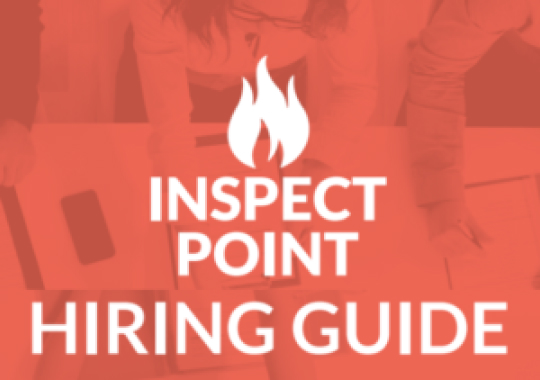
When it comes to fire code inspections, the Authority Having Jurisdiction (AHJ) plays a vital role in certifying that the fire and life safety systems in your building are up to date and up to National Fire Protection Agency (NFPA) standards.
Many of us – whether a business owner or employee – generally don’t know who their AHJ is, let alone what “Authority Having Jurisdiction” even means. Here’s where we come in to translate the regulatory lingo and equip you with the tools you need to ensure compliance for your business, facility, or properties.

We at Inspect Point want to make sure you know what to do when (or if) the AHJ in your district comes knocking. Working with your AHJ doesn’t have to be a challenge. The following tips will help you know what to expect, prepare for, and understand so you can answer that door feeling confident and comfortable with the fire inspection process for your building.
Understand the NFPA Standards and Codes
First and foremost, it’s important to understand what an AHJ is. According to NFPA 701 codes and standards, an authority having jurisdiction is “an organization, office, or individual responsible for enforcing the requirements of a code or standard, or for approving equipment, materials, an installation, or a procedure.” Essentially, this means the AHJ serves as an official body responsible for code interpretation, implementation, and enforcement.
The United States’ codes and standards development process can be confusing. Unlike many other countries, there is no federal government code, so your AHJ requirements may differ depending on where your building is located. Businesses with multiple properties across municipalities or states might see widely varying AHJ requirements. Furthermore, the codes your AHJ is employed to enforce can differ depending on which edition of the code your jurisdiction has adopted. It’s essential to recognize that, once a code is adopted by a jurisdiction, it should be noted as law for that jurisdiction.
Another important thing to note: AHJs often take time to adopt the newest code year. Always be sure your building is compliant with the code year set by your AHJ and that you’re submitting the proper documentation to prove compliance.
Know What Your Authority Having Jurisdiction Requires
You should also be aware that your AHJ’s responsibility could very well be split between several different individuals, offices, or other organizations given authority. The requirements your AHJ is employed to enforce depend mostly on the type of building or property. Their main objective is to evaluate the overall condition of the fire, life, and electric safety performance on your property and to confirm or request that it meets those up-to-date expectations.
Specifically, under the NFPA 701 annexes, it’s noted that, “Where public safety is primary, the AHJ may be a federal, state, local, or other regional department or individual such as a fire chief; fire marshal; chief of a fire prevention bureau, labor department, or health department; building official; electrical inspector; or others having statutory authority.” Assuming your property is insured, the insurance company may also serve as an authority having jurisdiction.

The NFPA notes that, commonly, the “property owner or his or her designated agent” takes on the AHJ role. For government installations, the commanding officer or departmental official can also assume the AHJ role.
The Building Operating Management & Facility Maintenance Decisions (BOMFMD) magazine provides a clear example. Think of commercial buildings: A hospital, for instance, would likely be subjected to multiple AHJs’ approvals primarily because of the high-rate safety services they provide. The BOMFMD Magazine breaks down what this means for the organization in question and the AHJ on a local, state, federal, and private level:
- Local government: building department, fire department
- State government: state fire marshal, state health department
- Federal government: Centers for Medicare & Medicaid Services
- Private sector: insurance company, third party certification/accreditation organizations
Compliance is Key When Working with the Authority Having Jurisdiction
As we’ve mentioned, the NFPA requires fire inspections primarily where public safety is critical. That’s not to say your property serves as a risk to public safety, but that proper care of your facility ensures public safety. And your authority having jurisdiction is there to corroborate this.
Keep in mind, their main objective is not to hassle you or burden your business, but to verify your building is safe for everyone. If your AHJ expects you to make changes, it is in the best interest of you as an owner, your occupants and/or customers, and your community as a whole.

In case of an emergency, any requested modifications also benefit your first responders. For instance, if a fire were to start in your building, first responders will assume your life safety systems are up to date. If you have failed to follow AHJ instructions, a first responders’ ability to take control of a possibly dangerous situation could be compromised. Not only is this a disservice to the overall safety of your community, but may incur legal ramifications–in which case, you may already be out of luck.
To reiterate, your AHJ has your best interests in mind as well as the interests of other involved parties, including members of your community.
Get to Know Your AHJ and Keep Them Around
In the most general sense, if you’re a building owner, your AHJ is your ally – so it’s important to treat them as such and take them seriously when they require inspections or compliance documentation. Keep an open mind and provide the utmost transparency when relaying information pertaining to the building to maintain a positive relationship with your AHJ–and ensure the safety of everyone who enters your building.
Sustaining a positive relationship with your AHJ(s) also provides you with the opportunity to know your building inside and out, helping you conserve the integrity of the building and, therefore, your business. It will also help you in case something goes wrong – you’ll be able to effectively communicate where the issue is to provide those in charge of fixing or inspecting the issue with all the facts. Awareness of what’s going on in your building and your fire protection systems is good for you and good for your AHJ.

Preserving this close relationship with your AHJ will also ensure they uphold that allied bond as well. Remember, your AHJ isn’t your enemy. Your AHJ is your friend! It’s up to you to maintain a good rapport. No matter the condition of your building(s), a good relationship with the AHJ can only improve your business and safety situation.
Document Inspections/Correspondences and Follow Up
Our final tip for working effectively with your AHJ is to document, document, document! Again, it’s as beneficial for you as it is the AHJ when you both are (literally) on the same page. Take notes during inspections, save all paperwork, and don’t be afraid to ask questions.

Chances are, if you lack the knowledge, you’ll be left wondering what to do when your AHJ shows up. At Inspect Point, we don’t want that to happen. After all, your success is our success – and we can mutually agree a safe building is the best kind of building.

